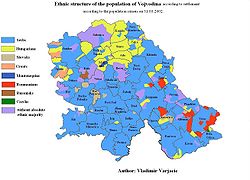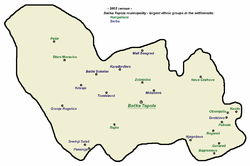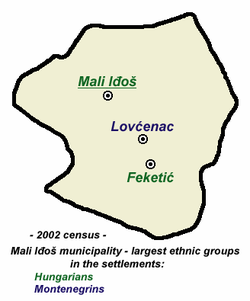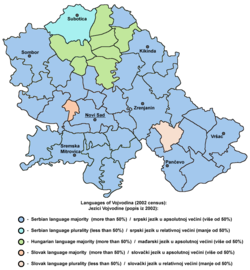- Hungarians in Vojvodina
-
Hungarians in Vojvodina
Vajdasági magyarok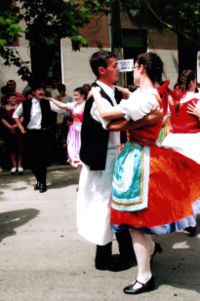
Total population  Serbia;
Serbia;  Vojvodina province: 290,207
Vojvodina province: 290,207
 Serbia; Central Serbia: 3,092 (mostly in Belgrade)
Serbia; Central Serbia: 3,092 (mostly in Belgrade)
 Hungary: unknown
Hungary: unknownRegions with significant populations Serbia (Vojvodina, Belgrade), Hungary Languages Hungarian (southern dialect)
Religion Predominantly Roman Catholic, minority are Protestants
Hungarians are the second largest ethnic group in the Vojvodina province in northern Serbia. According to the 2002 census, there are 290,207 ethnic Hungarians in Vojvodina who compose 14.28% of the provincial population. The number of ethnic Hungarians in the whole of Serbia is 293,299, and their participation for the overall population of Serbia is 3.91%. The majority of Hungarians in Vojvodina are Roman Catholics by faith, while smaller numbers of them are Protestant (mostly Calvinist). The Hungarian language is one of the six official languages of Vojvodina.
Contents
Geography
Most of the Hungarians (59.71% of the total) live in the northern part of Vojvodina, in the eight municipalities where they form the absolute or relative majority. The municipalities with an absolute Hungarian majority are: Kanjiža (86.52%), Senta (80.51%), Ada (76.64%), Bačka Topola (58.94%), Mali Iđoš (55.92%) and Čoka (51.56%). The ethnically mixed municipalities with relative Hungarian majority are Bečej (48.83%) and Subotica (38.47%). The multi-ethnic city of Subotica is a cultural and political centre for the Hungarians in Vojvodina. Protestant Hungarians forming the plurality or majority of population in the settlements of Stara Moravica, Pačir, Feketić, Novi Itebej and Debeljača.
Settlements with Hungarian majority
This is a list of the settlements in Vojvodina with absolute or relative Hungarian majority based on the 2002 census data.
In Subotica municipality:
- Subotica (Hungarian: Szabadka)
- Palić (Hungarian: Palics)
- Hajdukovo (Hungarian: Hajdújárás)
- Bački Vinogradi (Hungarian: Bácsszőlős)
- Šupljak (Hungarian: Ludas)
- Čantavir (Hungarian: Csantavér)
- Bačko Dušanovo (Hungarian: Zentaörs)
- Kelebija (Hungarian: Kelebia)
In Bačka Topola municipality:
- Bačka Topola (Hungarian: Topolya)
- Bajša (Hungarian: Bajsa)
- Pačir (Hungarian: Pacsér)
- Stara Moravica (Hungarian: Ómoravica or Bácskossuthfalva)
- Zobnatica (Hungarian: Andrásnépe)
- Bogaraš (Hungarian: Bogaras-Félváros)
- Obornjača (Hungarian: Nagyvölgy)
- Bagremovo (Hungarian: Brazília)
- Gunaroš (Hungarian: Gunaras)
- Novo Orahovo (Hungarian: Zentagunaras)
- Kavilo (Hungarian: Rákócifalu or Kavilló)
- Pobeda (Hungarian: Győztes or Pobedabirtok)
In Mali Iđoš municipality:
In Kanjiža municipality:
- Kanjiža (Hungarian: Magyarkanizsa)
- Adorjan (Hungarian: Adorján)
- Doline (Hungarian: Völgyes)
- Horgoš (Hungarian: Horgos)
- Male Pijace (Hungarian: Kispiac)
- Mali Pesak (Hungarian: Kishomok)
- Martonoš (Hungarian: Martonos)
- Novo Selo (Hungarian: Újfalu)
- Orom (Hungarian: Orom)
- Totovo Selo (Hungarian: Tóthfalu)
- Trešnjevac (Hungarian: Oromhegyes)
- Zimonić (Hungarian: Ilonafalu)
In Senta municipality:
- Senta (Hungarian: Zenta)
- Gornji Breg (Hungarian: Felsőhegy)
- Bogaraš (Hungarian: Bogaras)
- Tornjoš (Hungarian: Tornyos)
- Kevi (Hungarian: Kevi)
In Ada municipality:
- Ada (Hungarian: Ada)
- Mol (Hungarian: Mohol)
- Utrine (Hungarian: Törökfalu)
- Obornjača (Hungarian: Völgypart-Nagyvölgy)
- Sterijino (Hungarian: Valkaisor)
In Bečej municipality:
- Bečej (Hungarian: Óbecse)
- Bačko Gradište (Hungarian: Bácsföldvár)
- Bačko Petrovo Selo (Hungarian: Péterréve)
- Mileševo (Hungarian: Mileševo)
In Čoka municipality:
- Čoka (Hungarian: Csóka)
- Padej (Hungarian: Padé)
- Jazovo (Hungarian: Hódegyháza)
- Banatski Monoštor (Hungarian: Kanizsamonostor)
- Vrbica (Hungarian: Egyházaskér)
- Crna Bara (Hungarian: Feketetó)
In Novi Kneževac municipality:
In Kikinda municipality:
- Sajan (Hungarian: Szaján)
In Nova Crnja municipality:
- Nova Crnja (Hungarian: Magyarcsernye)
- Toba (Hungarian: Tóba)
In Žitište municipality:
- Torda (Hungarian: Torda)
- Hetin (Hungarian: Tamásfalva or Hetény)
- Novi Itebej (Hungarian: Magyarittabé)
In Zrenjanin municipality:
- Mihajlovo (Hungarian: Magyarszentmihály)
- Lukino Selo (Hungarian: Lukácsfalva)
In Sečanj municipality:
- Busenje (Hungarian: Káptalanfalva)
In Kovačica municipality:
- Debeljača (Hungarian: Torontálvásárhely)
In Plandište municipality:
- Jermenovci (Hungarian: Ürményháza)
In Vršac municipality:
- Šušara (Hungarian: Fejértelep)
In Bela Crkva municipality:
- Dobričevo (Hungarian: Udvarszállás)
In Kovin municipality:
- Skorenovac (Hungarian: Székelykeve)
- Šumarak (Hungarian: Emánueltelep)
In Pančevo municipality:
- Ivanovo (Hungarian: Sándoregyháza)
In Irig municipality:
In Odžaci municipality:
- Bogojevo (Hungarian: Gombos)
In Sombor municipality:
- Doroslovo (Hungarian: Doroszló)
- Telečka (Hungarian: Bácsgyulafalva or Telecska)
- Bezdan (Hungarian: Bezdán)
- Svetozar Miletić (Hungarian: Nemesmillitics)
In Apatin municipality:
History
Parts of the Vojvodina region were included into the medieval Kingdom of Hungary in the 10th century, and Hungarians then began to settle in the region, which before that time was mostly populated by Slavs. During Hungarian administration, Hungarians formed the largest part of population in northern parts of the region, while southern parts were populated by sizable Slavic population. Following the Ottoman conquest and inclusion of Vojvodina into Ottoman Empire in the 16th century, most of the Hungarian population fled from the region. During Ottoman administration, Vojvodina region was mostly populated by Serbs and Muslims. New Hungarian settlers started to come to the region with the establishment of the Habsburg administration at the beginning of the 18th century, mostly after the Peace of Passarowitz (Požarevac).
Count Imre Csáky settled Hungarians in his possessions in Bačka in 1712. In 1745, Hungarian colonists settled in Senta, in 1750 in Topola, in 1752 in Doroslovo, in 1772 in Bogojevo, in 1760 in Stara Kanjiža, in 1764 in Iđoš, in 1767 in Petrovo Selo, in 1776 in Martonoš, in 1786 in Pačir and Turski Sentmikloš, in 1787 in Piroš, and in 1789 in Feketić. Between 1782 and 1786, Hungarians settled in Crvenka and Stara Moravica, and in 1794 in Kula.
Hungarians of Roman Catholic faith originated mostly from Dunántúl, while Hungarians of Protestant faith originated mostly from Alföld. Between 1751 and 1753, Hungarians settled in Mol and Ada (Those originated mostly from Szeged and Jászság). In 1764–1767, Hungarians settled in Subotica, Bajmok and Čantavir, and in 1770 again in Kanjiža, Mol, Ada and Petrovo Selo, as well as in Feldvarac, Sentomaš and Turija.
In Banat, the settling of Hungarians started later. In 1784 Hungarians settled in Padej and Nakovo, in 1776 in Torda, in 1786 in Donji Itebej, in 1796 in Beodra and Čoka, in 1782 in Monoštor, in 1798 in Mađarska Crnja, in 1773 in Krstur and Majdan, in 1774 in Debeljača, in 1755–1760 in Bečkerek, and in 1766 in Vršac. In 1790, 14 Hungarian families from Transylvania settled in Banat.
In the 19th century, the Hungarian colonization increased. From the beginning of the century, the Hungarian individuals and small groups of settlers from Alföld constantly immigrating to Bačka. In the first half of the 19th century larger and smaller groups of the colonists settled in Mol (in 1805), as well as in Feldvarac, Temerin and Novi Sad (in 1806). In 1884, Hungarian colonists settled in Šajkaška and in Mali Stapar near Sombor. In 1889, Hungarians were settled in Svilojevo near Apatin and in 1892 in Gomboš, while another group settled in Gomboš in 1898. Many Hungarian settlers from Gomboš moved to Bačka Palanka. After the abolishment of the Military Frontier, Hungarian colonists were settled in Potisje, Čurug, Žabalj, Šajkaški Sveti Ivan, Titel and Mošorin. In 1883 around 1,000 Székely Hungarians settled in Kula, Stara Kanjiža, Stari Bečej and Titel.
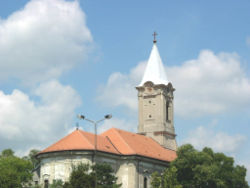 Catholic Church in Čoka
Catholic Church in Čoka
In 1800, smaller groups of Hungarian colonists from Dunántúl settled in Čoka, while in the same time colonists from Csanád and Csongrád counties settled in area around Itebej and Crnja, where they at first lived in scattered small settlements, and later they formed one single settlement - Mađarska Crnja. In 1824, one group of colonists from Čestereg also settled in Mađarska Crnja. In 1829 Hungarians settled in Mokrin, and in 1880 an even larger number of Hungarians settled in this municipality. In 1804, Hungarian colonists from Csongrád county settled in Firiđhaza (which was then joined with Turska Kanjiža), as well as in Sajan and Torda. Even a larger group of Hungarians from Csongrád settled in 1804 in Debeljača. In 1817–1818 Hungarians settled in Veliki Bikač, and in 1820–1840 smaller groups of Hungarians settled in Vranjevo. In 1826, colonists from Jászság and Kunság settled in Arač near Beodra. In 1830, Hungarians from Alföld settled in Veliki Lec, in 1831 in Ostojićevo, in 1832 in Malenčino Selo near Veliki Gaj, in 1839 and 1870 in Padej, in 1840 in Jermenovci and Mađarski Sentmihalj, in 1840–1841 in Dušanovac, in 1841 in Hetin, in 1859 in Sanad, in 1869 in Đurđevo (later moved to Skorenovac), and in 1890 in Gornja Mužlja. In 1883-1886, Székely Hungarians from Bukovina were settled in Vojlovica, Skorenovac, Ivanovo and Đurđevo. Total number of Székely colonists was 3,520.
The first Hungarian settlers in Srem moved there during 1860s from neighbouring counties, especially from Bačka.
According to the 1880 census, the Hungarians were third largest ethnic group in the Vojvodina region and made up 22.6% in the population (the largest group were Serbs with 35.5%, and the second largest were Germans with 24.4%). In the next census, in 1890, the Hungarians were the second largest group, having increased to 24.4% (The Serb participation was 34.4%, and German was 24.2%). By the 1910 census, the percent of ethnic Hungarians had increased to 28.1% (with the percent of Serbs at 33.8%, and the percent of Germans at 21.4%).
The new temporary borders established in 1918 and permanent ones defined by the Treaty of Trianon in 1920 put an end to Hungarian immigration. After World War I, present-day Vojvodina was included into the newly formed Kingdom of Serbs, Croats, and Slovenes (later known as the Kingdom of Yugoslavia) and many Hungarians of Vojvodina wanted to live in the post-Trianon Hungarian state, thus, some of them immigrated to Hungary, which was a destination for several emigration waves of Hungarians from Vojvodina. The inter war period was generally marked by a standstill of the Hungarian population. During these times, their numbers were at around 363,000 (1921 census) - 376,000 (1931 census) and they constituted about 23-24% of the entire population of Vojvodina. The outbreak of the Second World War caused some changes in population numbers, but more importantly it created tensions between the Hungarian and Serb communities.
With the onset of World War II, the Hungarian-Serb relations were low. Nazi Germany, in accordance to its "Operation Punishment" plan, invaded Yugoslavia, and subsequently, Axis Hungarian forces occupied Bačka. This region was annexed by Hungary, and it was colonized by new Hungarian settlers, at which time number of Hungarians in the area grew considerably, while in the same time many Serbs were expelled from Bačka. The brutal conduct of the Axis Hungarian occupying forces, or more notably the Hungarian army and Royal Hungarian Gendarmes, has extremely polarized both, Hungarian and Serb communities. Under the Axis Hungarian authority, 19,573 people were killed in Bačka, of which the majority of victims were of Serb, Jewish and Roma origin.
Although, part of the local Hungarian population supported Hungarian Axis authorities, many other local Hungarians opposed Axis rule and fought against it together with Serbs and other peoples of Vojvodina in the partisan resistance movement organized by the communist party. In some places of Vojvodina (Bačka Topola, Senta), most of the members of the communist party were ethnic Hungarians. In Subotica, the party secretary and most of the leadership were either ethnic Hungarians either Hungarian-speaking Jews. In the Bačka Topola municipality, 95% of communists were ethnic Hungarians. One of the leaders of the partisan resistance movement in Vojvodina was Erne Kiš, ethnic Hungarian, who was captured by the Axis authorities, sentenced to death by the court in Szeged and executed.
Among the other actions of the resistance movement, the first corn stacks were burned near Futog by five communists, of whom two were ethnic Hungarians - Antal Nemet and Đerđ Nemet. Antal Nemet was killed there, together with his Serb comrade, in the fighting against gendarmes, while his brother was captured and killed in Novi Sad because he did not reveal any information about resistance movement. The corn stacks were soon also burned near Subotica. The communists that burned these corn stacks were arrested, tortured and sent to court. The court sentenced two of them to death (Ferenc Hegediš and Jožef Liht), while five other were sentenced to prison (those five members of the group could not be sentenced to death because they were not adult).
The Axis authorities also arrested sizable number of Hungarian communists in Bačka Topola, Čantavir, Senta, Subotica and Novi Sad. Many of them were sent to investigation centre in Bačka Topola, where part of them was killed, while some committed suicide. Among those Hungarian communists who were sent to the centre were Otmar Majer, Đula Varga, Pal Karas, Janoš Koči, and others. Because of the size of the communist movement among Hungarians, new investigation centres were opened in Čantavir, Senta, Ada and Subotica. In the investigation centre in Subotica, almost 1,000 people were tortured, and part of them killed, among whom were Maćaš Vuković and Daniel Sabo. Among those communists sentenced to death were Otmar Majer, Rokuš Šimoković and Ištvan Lukač from Subotica, Peter Molnar from Senta, as well as Đula Varga, Rudi Klaus, Pal Karas and Janoš Koči from Novi Sad. In Petrovo Selo, Mihalj Šamu was killed during his attempt to escape. These actions of the Axis authorities were a hard struck on the resistance movement in Bačka, especially on its Hungarian component. The Hungarian component of the resistance movement was strucked so hard that it could not recuperate until the end of the war.
In 1944, the Soviet Red Army and the Yugoslav partisans took control of Vojvodina, and new communist authorities initiated purges against one part of local population that either collaborated with the Axis authorities or was viewed as a threat to the new regime (see: Communist purges in Serbia in 1944–1945). During this time, one number of local residents was executed. Victims of these executions were of different ethnic backgrounds and included Germans, Hungarians, Serbs, and other ethnicities. Estimates of the number of executed Hungarians are ranging from several thousands to several tens of thousands. The other part of the Hungarian population that supported new authorities was not only treated well by the new regime, but also participated in administration and army. For example, the 15th Vojvodinian partisan brigade that was founded in 1944 was composed entirely of Vojvodinian Hungarians.
Ever since the end of the Second World War, the Hungarian population has been steadily declining, mainly due to low birthrates and emigration. In 1974, the Yugoslav constitution was modified giving Vojvodina a very high level of autonomy and local Hungarians participated in Vojvodinian provincial administration. The Hungarians were also given the opportunity to keep their culture and language alive; they had their own schools and cultural institutions. During the reign of Josip Broz Tito, life in Vojvodina was peaceful for Hungarians as well as for others. The socialist regime heavily cracked down upon nationalist flareups.
As the Yugoslav wars were raging, more Hungarians left Vojvodina. One of the reasons for this emigration was the ruined economy of the country and inability for employment, which was the reason why many Serbs as well as others also emigrated from Vojvodina. Although the province was peaceful and calm compared to other areas of Yugoslavia, some Hungarians felt threatened, especially because Vojvodina was near the front lines, during the War in Croatia. With an emigration of Hungarians from Vojvodina, one part of their former houses was used for resettlement of refugees from other parts of former Yugoslavia. This created a change of the ethnic structure in some parts of the region. The Hungarian population has fallen from 340,946 (16.9%) in 1991, to 290,207 (14.28%) in 2002. In recent years (mostly in 2004 and 2005), some members of the ethnic Hungarian community have sometimes been the targets of anti-Hungarian sentiments.
Today, many Hungarians in Vojvodina want their political rights to be extended. Some local Hungarian politicians proposing the creation of new autonomous region in northern part of Vojvodina inhabited mainly by Hungarians (see: Hungarian Regional Autonomy). They also want to attain Hungarian citizenship, without being Hungarian residents, as this would automatically make them EU citizens, giving many benefits. However, a referendum on this issue in Hungary failed. The political future of Vojvodinian Hungarians is uncertain, as their community is characterized by low birthrates and a dwindling population - according to some demographic predictions, Hungarians of Vojvodina will probably lost ethnic majority/plurality in some municipalities and sizable towns, but they will certainly remain in majority in one number of municipalities and settlements. Thus, while Hungarians will remain notable ethnic group in northern part of Vojvodina, partial demographic changes in the area will probably reduce demands of local Hungarian politicians for territorial autonomy or at least for wide territorial extension of the proposed Hungarian autonomous region.
Culture
- Magyar Szó, a Hungarian language daily newspaper published in Novi Sad until 2006, when its offices were relocated to Subotica.
- Radio Television of Vojvodina broadcasts programme in 10 local languages, including daily radio and TV shows in Hungarian language.
Famous Hungarians from Vojvodina
- András Ágoston, politician, leader of the Democratic Party of Vojvodina Hungarians.
- Géza Csáth (1887-1919), a tragic physician-writer.
- Zoltán Dani, a former colonel of the Yugoslav Army and former commander of the 3rd battery of the 250th Missile Brigade, which shot down an F-117 Nighthawk near the village of Buđanovci on 27 March 1999, during the Kosovo War.
- József Kasza, politician, former leader of the Alliance of Vojvodina Hungarians.
- Mihály Kertész, politician, a close associate and man of trust of Slobodan Milošević, during 1990s.
- Dezső Kosztolányi (1885-1936), one of the most famous Hungarian writers.
- Félix Lajkó (b. 1974 in Subotica), a "world music" violinist and composer.
- Péter Lékó (b. 1979 in Subotica), Hungary's number one chess player.
- Sylvester Levay, a Hungarian composer. He was born in 1945 in Subotica.
- John Marlyn, a Canadian writer of ethnic Hungarian origin. He was born in 1912 in Bečkerek (Hungarian: Nagybecskerek), the modern Zrenjanin.
- Gyula Mester, a Yugoslav/Serbian volleyball player.
- László Moholy-Nagy, a Hungarian painter and photographer, notable professor of the Bauhaus school.
- Sándor Páll (1954-2010), politician, former leader of the Democratic Fellowship of Vojvodina Hungarians.
- István Pásztor, politician, leader of the Alliance of Vojvodina Hungarians.
- Eva Ras (born Balazs/Balaš), a Serbian actress.
- Magdolna Rúzsa, a singer who won the title of the third season of Megasztár (Hungarian Idol).
- Árpád Sterbik (Árpád Sterbik), Yugoslav/Serbian handball player.
- Mónika Szeles (Monika Seleš), a former World No.1 female tennis player. She was born in 1973, in Novi Sad.
- Csaba Szilágyi, a Serbian swimmer.
Politics
There are five main ethnic Hungarian political parties in Vojvodina:
- Alliance of Vojvodina Hungarians, led by István Pásztor
- Democratic Community of Vojvodina Hungarians, led by Áron Csonka
- Democratic Party of Vojvodina Hungarians, led by András Ágoston
- Civic Alliance of Hungarians, led by László Rác Szabó
- Movement of Hungarian Hope, led by Bálint László
These parties are advocating the establishment of the territorial autonomy for Hungarians in the northern part of Vojvodina, which would include the municipalities with Hungarian majority (See Hungarian Regional Autonomy for details).
See also
- Ethnic groups of Vojvodina
- Hungarian exonyms (Vojvodina)
- Hungarians in Slovakia
- Hungarian minority in Romania
- Székely
- Hungarian-Serbian relations
Further reading
- Arday, Lajos (September 1996). "Hungarians in Serb-Yugoslav Vojvodina since 1944". Nationalities Papers 24 (3): 467–482. doi:10.1080/00905999608408460.
References
- Karolj Brindza, Učešće jugoslovenskih Mađara u narodnooslobodilačkoj borbi, Vojvodina u borbi, Matica Srpska, Novi Sad, 1951.
- Borislav Jankulov, Pregled kolonizacije Vojvodine u XVIII i XIX veku, Novi Sad - Pančevo, 2003.
- Peter Rokai - Zoltan Đere - Tibor Pal - Aleksandar Kasaš, Istorija Mađara, Beograd, 2002.
- Enike A. Šajti, Mađari u Vojvodini 1918-1947, Novi Sad, 2010.
- Aleksandar Kasaš, Mađari u Vojvodini 1941-1946, Novi Sad, 1996.
External links
- (Hungarian) The encyclopedia of Vojvodina
- Hungarian population in the territory of present-day Vojvodina between 1880 and 1991
- Ethnic Hungarian Minorities in Central and Eastern Europe
Ethnic groups in Serbia Central Serbia Serbs · Albanians · Bosniaks · Ethnic Muslims · Bulgarians · Croats · Macedonians · Montenegrins · Roma · Romanians (Vlachs) · YugoslavsVojvodina Banat Bulgarians · Bunjevci · Croats (Šokci) · Germans (Danube Swabians and Banat Swabians) · Hungarians (Szekelys) · Montenegrins · Macedonians · Pannonian Rusyns · Roma · Serbs · Slovaks · Yugoslavs · Romanians · Czechs · Slovenes · Gorani people · Ukrainians · Albanians · RussiansKosovo[a] ^a Kosovo is the subject of a territorial dispute between the Republic of Serbia and the self-proclaimed Republic of Kosovo. The latter declared independence on 17 February 2008, while Serbia claims it as part of its own sovereign territory. Its independence is recognised by 85 UN member states.Hungarian diaspora Africa Asia IsraelEurope Austria · Croatia · Germany · Romania (incl. Székelys, Csángó) · Serbia (incl. Székelys of Bukovina) · Slovakia · Slovenia · Ukraine · United KingdomAmericas Oceania Australia · New ZealandCategories:- Hungarians in Vojvodina
- Serbian people of Hungarian descent
- Hungarian minorities in Europe
- Ethnic groups in Vojvodina
- Ethnic groups in Serbia
Wikimedia Foundation. 2010.



